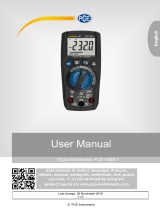© PCE Instruments
4
6.2 On / off, sensitivity
Transmitter
Slide the switch on the left side of the transmitter to the position required for the measuring task.
To test the battery, slide the switch to the "TONE" position. If the red LED is not lit, replace the
battery.
To switch off, slide the switch to the middle position.
Receiver
Turn on the receiver using the rotary control on the right-hand side.
The further you turn the control clockwise, the greater the search depth.
When tracing a cable or performing other tests that require the receiver, press and hold the
measurement key.
To switch off, turn the rotary control anticlockwise to the end position.
6.3 Cable detection / cable routing
Household / industrial installation
Make sure that the cable you are looking for is free of voltage.
Slide the switch on the transmitter to the "TONE" position.
Switch on the receiver by turning the rotary control to the middle position. Guide the sensor close
to the connection cables of the transmitter. As the sensor approaches the connection cable of the
transmitter, the volume of the signal on the receiver will increase.
If the ambient noise level exceeds the signal, connect headphones or earphones to the bottom of
the transmitter.
Connect the crocodile clips of the transmitter to one conductor each of the cable to be searched.
For shielded or coaxial cables, connect the red crocodile clip to the shield of the cable.
Press and hold down the measurement key on the receiver and follow the signal and thus the
cable with the sensor.
Car
Disconnect all voltage-sensitive parts or systems such as airbags, electronic control modules etc.
from the vehicle’s electrical system.
Slide the switch on the transmitter to the "TONE" position.
Switch on the receiver by turning the rotary switch to the middle position.
Guide the sensor close to the connection cables of the transmitter. As the sensor approaches the
connection cable of the transmitter, the volume of the signal at the receiver will increase.
If the ambient noise level exceeds the signal, connect headphones or earphones to the bottom of
the transmitter.
There are two options for connecting the transmitter:
- Connect the black terminal to the incoming conductor or to the positive pole of the
battery.
- Connect the red terminal to the conductor to be tracked.











